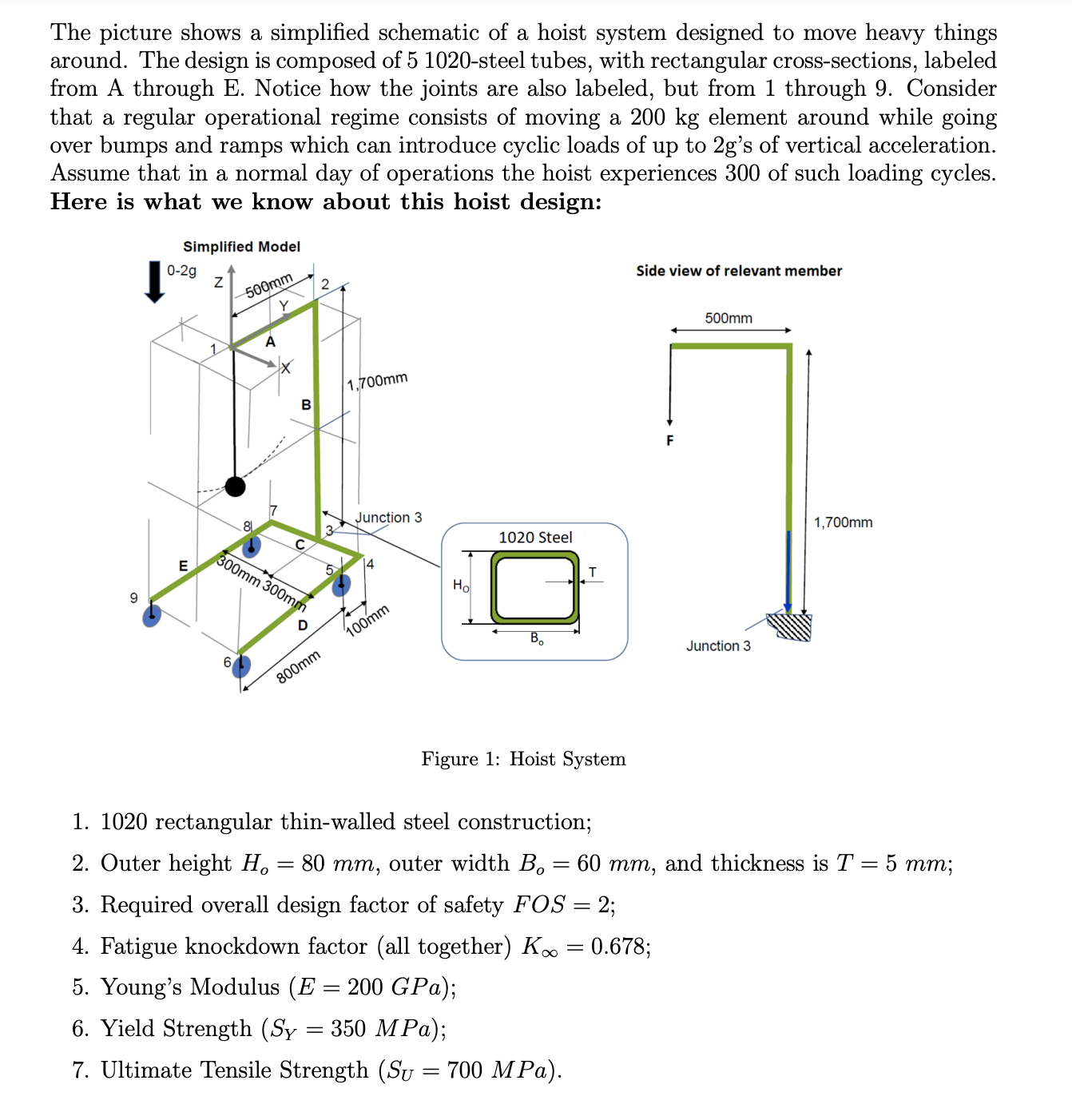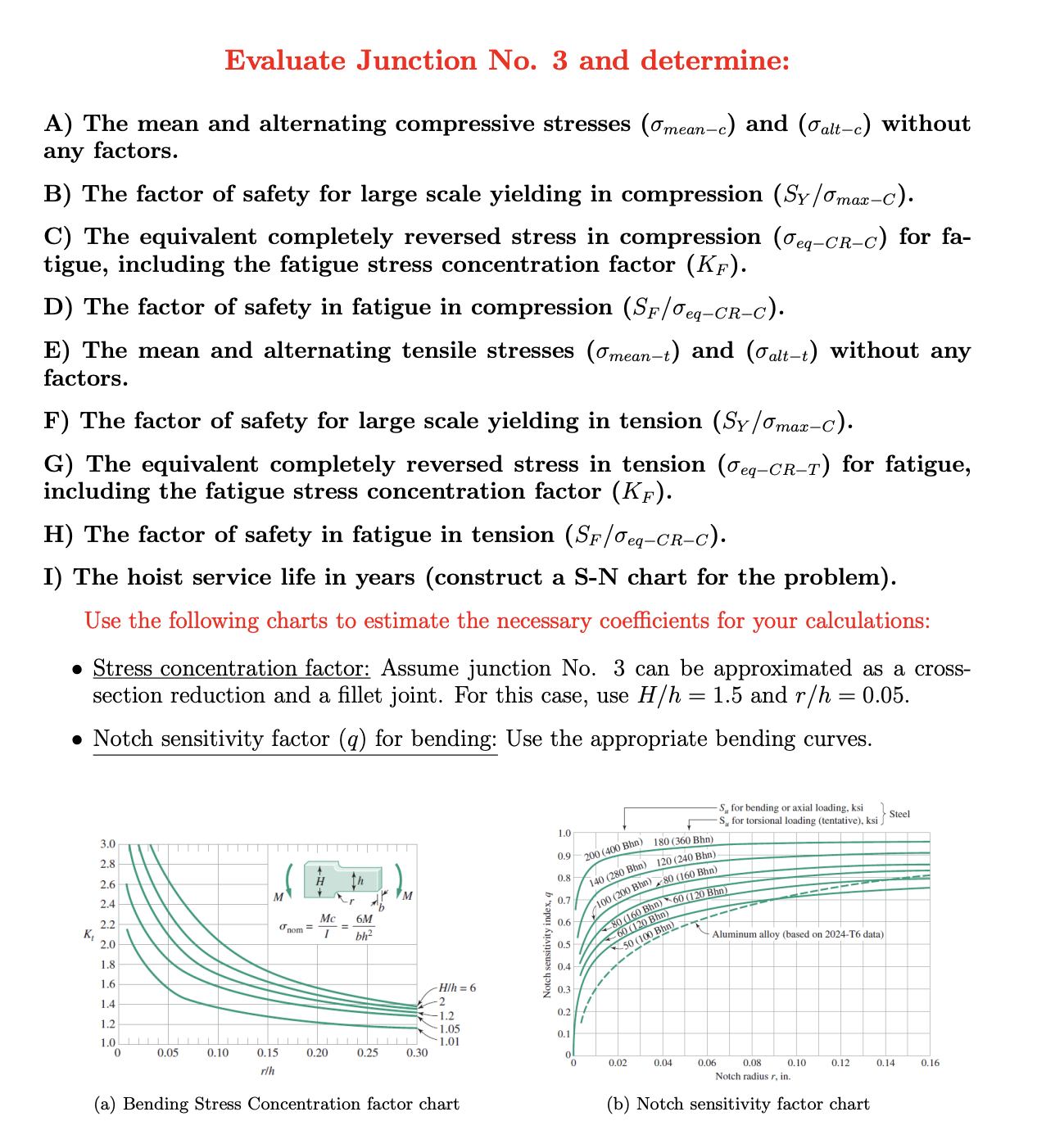Answered step by step
Verified Expert Solution
Question
1 Approved Answer
The picture shows a simplified schematic of a hoist system designed to move heavy things around. The design is composed of 5 1020-steel tubes,


The picture shows a simplified schematic of a hoist system designed to move heavy things around. The design is composed of 5 1020-steel tubes, with rectangular cross-sections, labeled from A through E. Notice how the joints are also labeled, but from 1 through 9. Consider that a regular operational regime consists of moving a 200 kg element around while going over bumps and ramps which can introduce cyclic loads of up to 2g's of vertical acceleration. Assume that in a normal day of operations the hoist experiences 300 of such loading cycles. Here is what we know about this hoist design: Simplified Model 0-2g E Z 500mm Y 8 A B C 300mm 300mm = 2 D 800mm 34 5 1,700mm Junction 3 100mm Ho 1020 Steel B Figure 1: Hoist System 1. 1020 rectangular thin-walled steel construction; 2. Outer height Ho 80 mm, outer width B. 3. Required overall design factor of safety FOS = 2; 4. Fatigue knockdown factor (all together) K 0.678; 5. Young's Modulus (E = 200 GPa); 6. Yield Strength (Sy = 350 MPa); 7. Ultimate Tensile Strength (Su = 700 MPa). = Side view of relevant member = F 500mm Junction 3 1,700mm 60 mm, and thickness is T = 5 mm; mean-c A) The mean and alternating compressive stresses (o -c) and (alt-c) without any factors. B) The factor of safety for large scale yielding in compression (Sy/max-c). C) The equivalent completely reversed stress in compression (eq-CR-C) for fa- tigue, including the fatigue stress concentration factor (KF). D) The factor of safety in fatigue in compression (SF/Oeq-CR-C). E) The mean and alternating tensile stresses (mean-t) and (alt-t) without any factors. F) The factor of safety for large scale yielding in tension (Sy/max_c). G) The equivalent completely reversed stress in tension (eq-CR-T) for fatigue, including the fatigue stress concentration factor (KF). Evaluate Junction No. 3 and determine: H) The factor of safety in fatigue in tension (SF/eq_CR-C). I) The hoist service life in years (construct a S-N chart for the problem). Use the following charts to estimate the necessary coefficients for your calculations: Stress concentration factor: Assume junction No. 3 can be approximated as a cross- section reduction and a fillet joint. For this case, use H/h = 1.5 and r/h = 0.05. Notch sensitivity factor (q) for bending: Use the appropriate bending curves. K 3.0 2.8 2.6 2.4 2.2 2.0 1.8 1.6 1.4 1.2 1.0 0.05 0.10 M 0.15 r/h nom = 4 th H kr Mc 6M I bh 0.20 = 0.25 M 0.30 H/h=6 -2 -1.2 -1.05 1.01 (a) Bending Stress Concentration factor chart Notch sensitivity index, q 1.0 0.9 0.8 0.7 0.6 0.5 0.4 0.3 0.2 0.1 OL 0 200 (400 Bhn) 180 (360 Bhn) 140 (280 Bhn) 120 (240 Bhn) 100 (200 Bhn) 80 (160 Bhn) 80 (160 Bhn)*60 (120 Bhn) 60 (120 Bhn) 50 (100 Bhn) 0.02 S for bending or axial loading, ksi S for torsional loading (tentative), ksi 0.04 0.08 0.10 Notch radius r, in. (b) Notch sensitivity factor chart Aluminum alloy (based on 2024-T6 data) 0.06 0.12 Steel 0.14 0.16
Step by Step Solution
There are 3 Steps involved in it
Step: 1

Get Instant Access to Expert-Tailored Solutions
See step-by-step solutions with expert insights and AI powered tools for academic success
Step: 2

Step: 3

Ace Your Homework with AI
Get the answers you need in no time with our AI-driven, step-by-step assistance
Get Started


